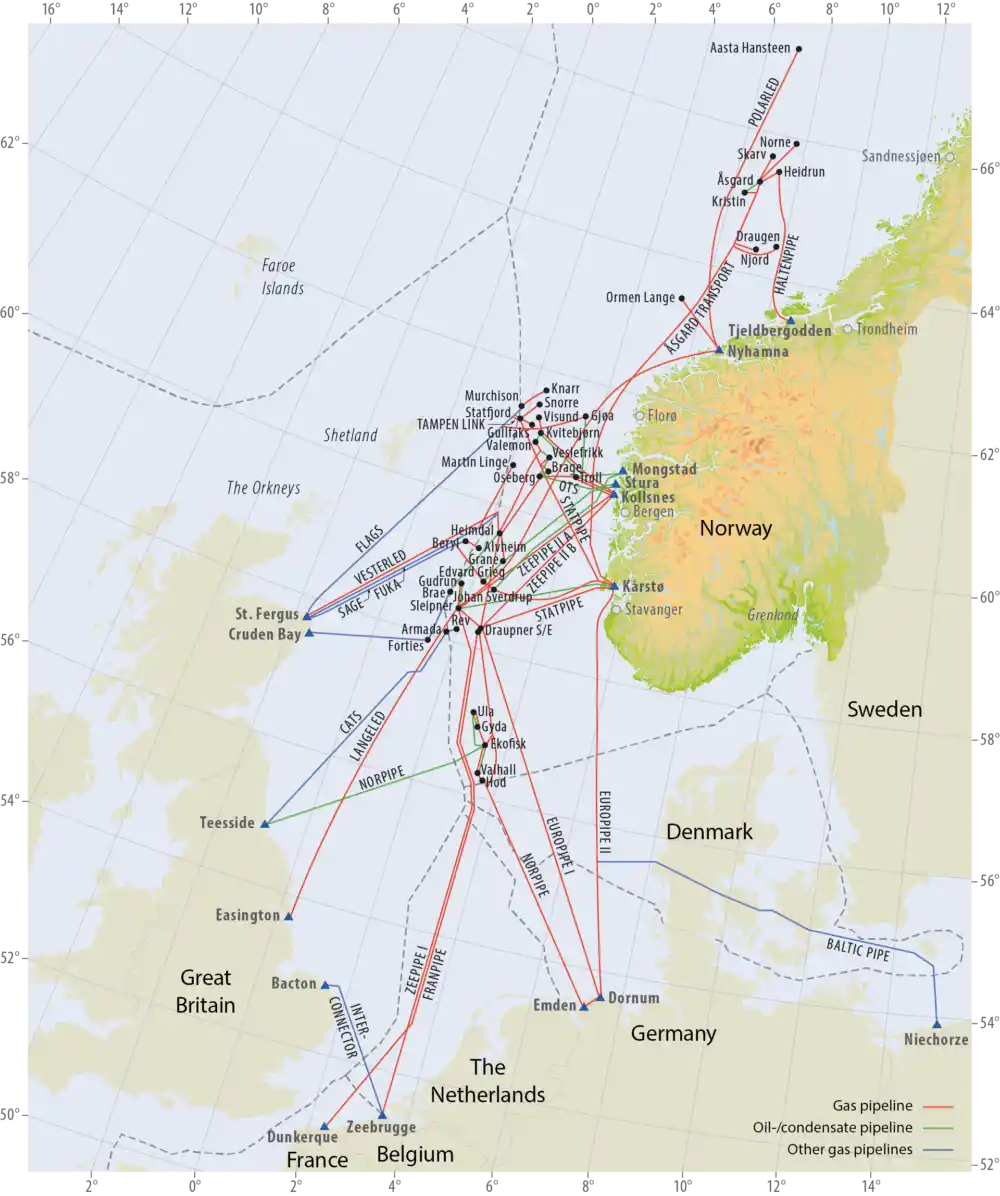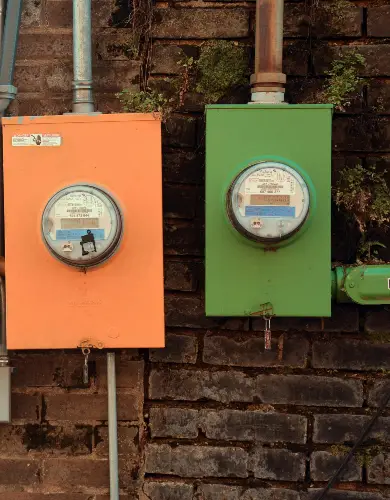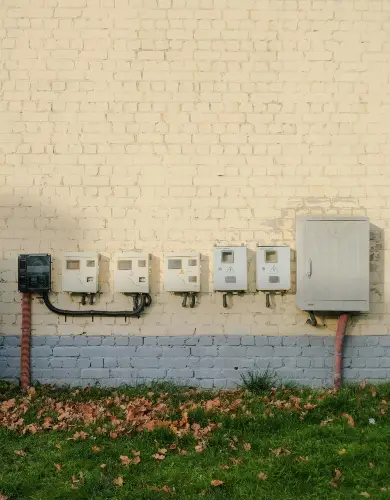The Langeled pipeline: A critical connection for the UK’s energy supply
The Langeled Pipeline is the world’s longest operational undersea gas pipeline, stretching 1,116 kilometres and connecting the British mainland to the gas fields of Norway. It provides a vital link between the UK and Europe’s most important source of natural gas.
The Langeled pipeline can supply up to a fifth of the UK’s natural gas demand. With domestic reserves in decline, the UK is becoming increasingly reliant on the gas it delivers.
This guide explores the Langeled Pipeline, including the route it takes, its vital importance for the UK’s energy supply and wider economy, and the security vulnerability it represents.
What is the Langeled pipeline?
The Langeled Pipeline is an undersea natural gas pipeline that connects Norway with the east coast of England.
With a diameter of 44 inches, the pipeline can deliver up to 72.1 million cubic metres of gas per day, making it the highest-capacity natural gas import route for the UK.
The pipeline was completed in 2006, in response to declining gas production from domestic fields on the UK side of the North Sea. It enables the large-scale import of gas from Norway.
It was originally developed by Equinor and is operated by Gassco, a Norwegian state-owned company responsible for managing Norway’s gas transport system.
💡 The Langeled Pipeline is designed to move gas in only one direction: from Norway to Britain. Norway has sufficient domestic gas production and therefore has no need for import capacity.
Langeled pipeline route: From Norway to the UK
The Langeled Pipeline begins at Nyhamna, on Norway’s west coast, where gas from the Ormen Lange field is processed. The pipeline then runs in two sections:
- Langeled North – This northern section runs from Nyhamna to the Sleipner hub in the North Sea. The Sleipner hub is a major offshore gas processing and distribution facility located in the Norwegian sector of the North Sea.
- Langeled South – The southern section continues across the UK side of the North Sea to Easington in Yorkshire. The pipeline terminates at the Easington Gas Terminal, which is owned by British Gas.
The Easington Gas Terminal is connected to the National Transmission System (NTS), the high-capacity nationwide section of Britain’s gas distribution network.
The map below shows the Langeled Pipeline route, along with other natural gas infrastructure in the North Sea.

Source: Norwegian Petroleum – The oil and gas pipeline system
Norway’s subsea gas pipeline network
The Langeled Pipeline is not the only major gas pipeline in the North Sea. The Norwegian sector of the North Sea is the single largest source of natural gas in Europe, relied upon not only by the UK but also by the European Union.
Here we summarise the other major subsea gas pipelines that enable the export of Norwegian gas.
Gas pipelines from Norway to the EU
Gassco operates the following three major pipelines, which allow direct exports of Norwegian gas to European Union member states:
- Europipe I and II – Two pipelines connecting the Kårstø and Kollsnes processing plants in Norway to Dornum in Germany.
- Franpipe – A pipeline connecting Norway’s Ekofisk field to Dunkirk in France.
- Zeepipe – A pipeline connecting Norway’s Sleipner hub to Zeebrugge in Belgium.
Gas pipelines from Norway to the UK
The Langeled Pipeline is one of six gas pipelines that enable the import of natural gas from Norwegian fields into Great Britain.
The other five pipelines (Vesterled, Tampen, Gjøa, SAGE, and CATS) do not provide a direct route to the UK. Instead, they connect Norwegian infrastructure to British gas fields, after which the gas is transported through domestic pipelines linking offshore platforms with the mainland.
Who operates the Langeled pipeline?
The Langeled Pipeline is operated by Gassco, the Norwegian state-owned company responsible for managing Norway’s entire gas transport system.
Gassco does not own the pipelines it operates; instead, it serves as a neutral system operator, ensuring the efficient and reliable transport of gas from offshore fields to European markets.
As a neutral operator, Gassco does not buy or sell gas itself. It transports gas on behalf of the companies that own the producing fields on the Norwegian continental shelf.
This neutral arrangement has helped make Norway one of the most trusted and reliable gas suppliers globally.
Importance of Langeled to the UK’s energy supply
The UK relies on natural gas for electricity generation at gas power stations, for industrial processes, and for heating in both domestic and commercial properties.
This section uses the latest government statistics to explain the vital importance of Langeled to the UK’s energy supply.
Domestic gas production in the North Sea
In the UK sector of the North Sea (known as the UK Continental Shelf), there are approximately 90 producing gas fields. However, production from these facilities has been in steady decline since the early 2000s.
Until 2003, the UK’s domestic gas production was sufficient to meet national demand. Since then, however, the country has relied on imports to make up the shortfall.
Dependence on gas imports
The latest UK government report on natural gas demand and production demonstrates the UK’s continued reliance on gas imports. In 2024, overall UK demand was 688,624 GWh, which was supplied by:
- Domestic production – 343,722 GWh
- Net gas imports – 334,873 GWh
- Changes in natural gas storage – 10,029 GWh
The 2024 figures are consistent with the general trend over the last decade, in which approximately half of the UK’s gas demand has been met by imports.
UK’s sources of gas imports
The UK relies on a mix of pipeline imports and liquefied natural gas (LNG) to meet its gas needs.
Here is a summary of the key routes for importing natural gas:
| Facility | Import type | Gas origin | Location | Max flow rate (million m³/day) |
|---|---|---|---|---|
| Bacton–Zeebrugge | Pipeline | Belgium | Zeebrugge ↔ Bacton | 70 |
| Balgzand Bacton Line | Pipeline | Netherlands | Balgzand ↔ Bacton | 45 |
| Langeled Pipeline | Pipeline | Norway | Nyhamna ↔ Easington | 72 |
| Vesterled Pipeline | Pipeline | Norway | Heimdal Riser Platform | 37 |
| Tampen Link | Pipeline | Norway | Statfjord ↔ St Fergus | 25 |
| Gjøa Pipeline | Pipeline | Norway | Gjøa/Vega ↔ St Fergus | 17 |
| SAGE Pipeline | Pipeline | Norway | Alvheim ↔ St Fergus | 5 |
| CATS Pipeline | Pipeline | Norway | Rev and Gaupe ↔ Teesside | 48 |
| South Hook | LNG terminal | Mixed | Milford Haven | 58 |
| Isle of Grain | LNG terminal | Mixed | Kent | 59 |
| Dragon | LNG terminal | Mixed | Milford Haven | 25 |
Source: gov.uk – United Kingdom energy statistics
In 2024, approximately 75% of the UK’s gas imports were transported via Norwegian pipelines. In general, wholesale gas markets prioritise pipeline gas, as it is typically cheaper to transport than LNG shipped by sea.
Why Langeled is the backbone of UK gas imports
The Langeled Pipeline from Norway is arguably the most crucial piece of infrastructure supporting the UK’s gas imports.
The first reason is its direct connection to Norwegian gas fields, the largest source of natural gas in Europe. The UK also has undersea pipeline links with Belgium and the Netherlands, but these countries ultimately depend on Norwegian gas supplies themselves. This means the most efficient route for UK imports is via the direct connection with Norway.
The second reason is the pipeline’s capacity. The Langeled Pipeline is the highest-capacity link between the UK and Norway. It is possible to route gas through alternative pipelines, but these are lower capacity and are already used to transport domestically produced gas.
The vital importance of Langeled to the UK’s energy supply is most clearly demonstrated by its direct impact on domestic and business gas prices.
Langeled’s role in wholesale gas prices
Because so much of the UK’s gas supply depends on imports, the availability of gas through undersea pipelines is a critical factor in setting wholesale prices.
When pipeline flows from Norway or continental Europe are strong, or when LNG shipments are plentiful, the UK system is well supplied and market prices remain relatively stable. However, if imports are disrupted and demand from domestic and business gas suppliers exceeds supply, wholesale prices can rise sharply.
Since Langeled is the UK’s most important natural gas import route, it has the greatest influence on prices. This was most clearly demonstrated by an incident on the pipeline in 2024.
June 2024 Langeled Crack and its market impact
In early June 2024, a crack was discovered in a small pipeline on Norway’s Sleipner Riser platform, a critical connector between the Langeled North and South sections.
This fault reduced gas flows from Norway’s Nyhamna processing plant to the UK’s Easington terminal via the Langeled Pipeline, cutting throughput by around 20%.
In response, day-ahead gas prices jumped nearly 12%, reaching their highest level in 2024.
The fault was repaired within a few days, with supply reduced for a total of five days, after which market prices quickly returned to normal.
That the market was so heavily affected by only a short and partial reduction in flows through Langeled demonstrates the pipeline’s crucial role in setting wholesale gas prices.
Why wholesale gas prices are important
Wholesale gas prices are the foundation of the UK energy market and have a powerful impact on the overall health of the economy.
The structure of the wholesale electricity markets means that the price of power generated by gas-fired power stations is the principal determinant of electricity prices. As a result, the market price of electricity closely tracks the price of gas.
The underlying costs faced by domestic and business energy suppliers rise and fall with the availability of gas imports, and when supply is restricted, these costs are passed on to consumers.
Beyond affecting household living standards in Britain, the competitiveness of British businesses also depends on the affordability and stability of commercial gas and business electricity prices.
Is the Langeled pipeline at risk of sabotage?
The economic importance of the Langeled Pipeline raises a serious question about its vulnerability to attack by hostile state actors.
The Langeled Pipeline lies exposed on the seabed in relatively shallow waters, which makes it susceptible to sabotage. Attacks on natural gas pipelines are not without precedent.
In September 2022, the Nord Stream pipelines in the Baltic Sea were deliberately damaged by a series of underwater explosions, rendering them inoperable.
Recognising this vulnerability, the UK government’s 2025 defence review recommended a more active role for the Royal Navy in protecting undersea energy infrastructure.

